Oxytocin's Link To Autism
Unlocking the Social Brain: The Role of Oxytocin in Autism Spectrum Disorder
Understanding Oxytocin’s Biological Connection to Autism
Over the past few decades, scientific research has increasingly focused on oxytocin, a hormone integral to social bonding and cognition, exploring its potential links to autism spectrum disorder (ASD). While some evidence suggests that alterations in the oxytocin system may contribute to the social impairments characteristic of autism, the precise role of oxytocin in the disorder remains complex and actively studied. This article delves into current research findings, biological mechanisms, and clinical trials to understand how oxytocin may influence autism and what this means for diagnosis and treatment.
Animal and Human Research on Oxytocin and Social Behavior
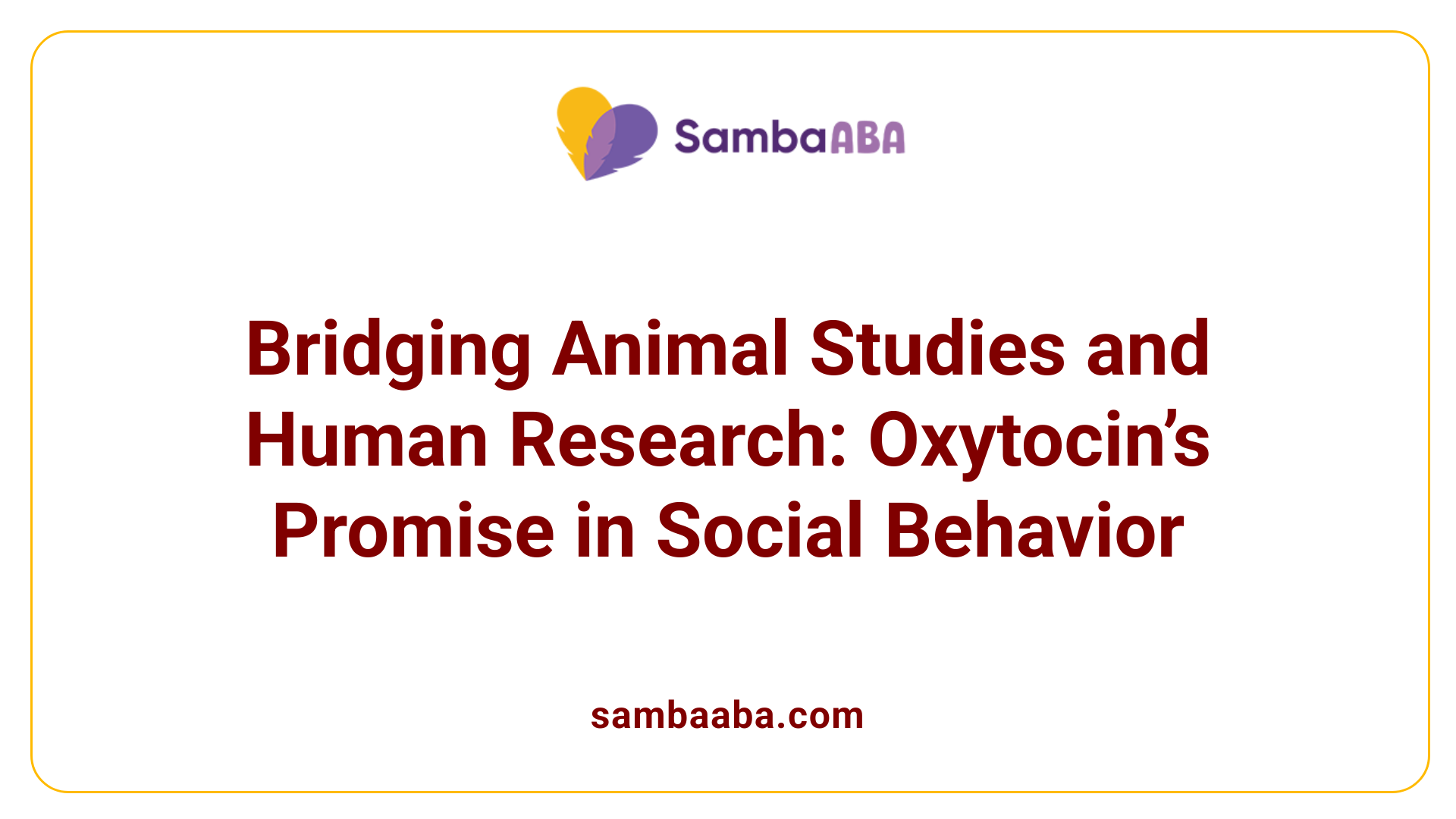
What does animal and human research tell us about oxytocin's role in social behavior and autism?
Research in animals, such as prairie voles, provides foundational insight into oxytocin's role in social behavior. These studies demonstrate that oxytocin is essential for establishing social bonds, such as pair bonding, and influences maternal behaviors and social recognition. Manipulating oxytocin levels in these animals can enhance or diminish social affiliation, suggesting that the hormone plays a pivotal role in social motivation and recognition mechanisms.
In humans, especially individuals with autism spectrum disorder (ASD), the relationship between oxytocin and social behavior has been extensively investigated. Several studies have reported that people with ASD tend to have lower levels of oxytocin in their blood and cerebrospinal fluid compared to neurotypical controls. These reduced levels are often correlated with social impairments, such as difficulties in face recognition, gaze behaviors, and social motivation.
Genetic research has identified associations between ASD and polymorphisms in the oxytocin receptor gene (OXTR). These genetic variations may influence how oxytocin signals are received and processed in the brain, potentially affecting social cognition and attachment behaviors. Some variants have been linked to increased risk for ASD, although the overall contribution of oxytocin-related genetics to autism remains complex and not entirely conclusive.
Clinical trials exploring intranasal oxytocin administration have yielded intriguing but mixed results. Certain studies have shown that oxytocin can transiently improve social attention—such as increased gaze toward faces and eyes—and enhance trust and harmony in social interactions among some autistic individuals. For example, a 2017 Stanford study found that children with low baseline oxytocin levels experienced notable improvements in social behaviors after nasal spray treatment. These effects seem to be more pronounced in subgroups characterized by initial oxytocin deficiency.
However, the overall efficacy across larger populations remains uncertain. Several large-scale, placebo-controlled trials report no significant long-term benefits from oxytocin therapy on core social symptoms of autism. The heterogeneity of responses suggests that oxytocin’s benefits may depend on individual differences, such as baseline oxytocin levels or genetic profiles.
The mechanism by which oxytocin influences social cognition involves neural pathways that modulate social salience, involving regions like the amygdala, nucleus accumbens, and prefrontal cortex. Functional imaging studies confirm that intranasal oxytocin can increase activity in these areas during social tasks, potentially improving social motivation. Nonetheless, variability in effects emphasizes the need for more targeted approaches.
Importantly, animal studies support the idea that interventions aimed at increasing oxytocin activity can enhance social recognition and reduce social deficits, but translation to humans has been challenging. Human research indicates that oxytocin's effects are highly context-dependent, influenced by developmental stage, individual biology, and environmental factors.
Ethical and clinical considerations also arise, as research suggests that oxytocin treatment might not be suitable for everyone with autism. Personalized medicine approaches, such as selecting individuals with low baseline oxytocin levels for targeted therapy, are under development. Moreover, understanding the neurobiological mechanisms remains critical to refining treatment strategies.
In summary, animal studies underscore the fundamental role of oxytocin in social bonding and recognition, which extends to human social cognition. Reduced oxytocin levels and receptor gene variations are linked to social impairments in autism, and intranasal oxytocin can temporarily enhance social attention and trust in some individuals. However, inconsistent findings and the complexity of social behaviors necessitate further research to establish oxytocin's full therapeutic potential and to develop more precise, personalized interventions.
Biological Mechanisms Underlying Oxytocin's Influence in Autism
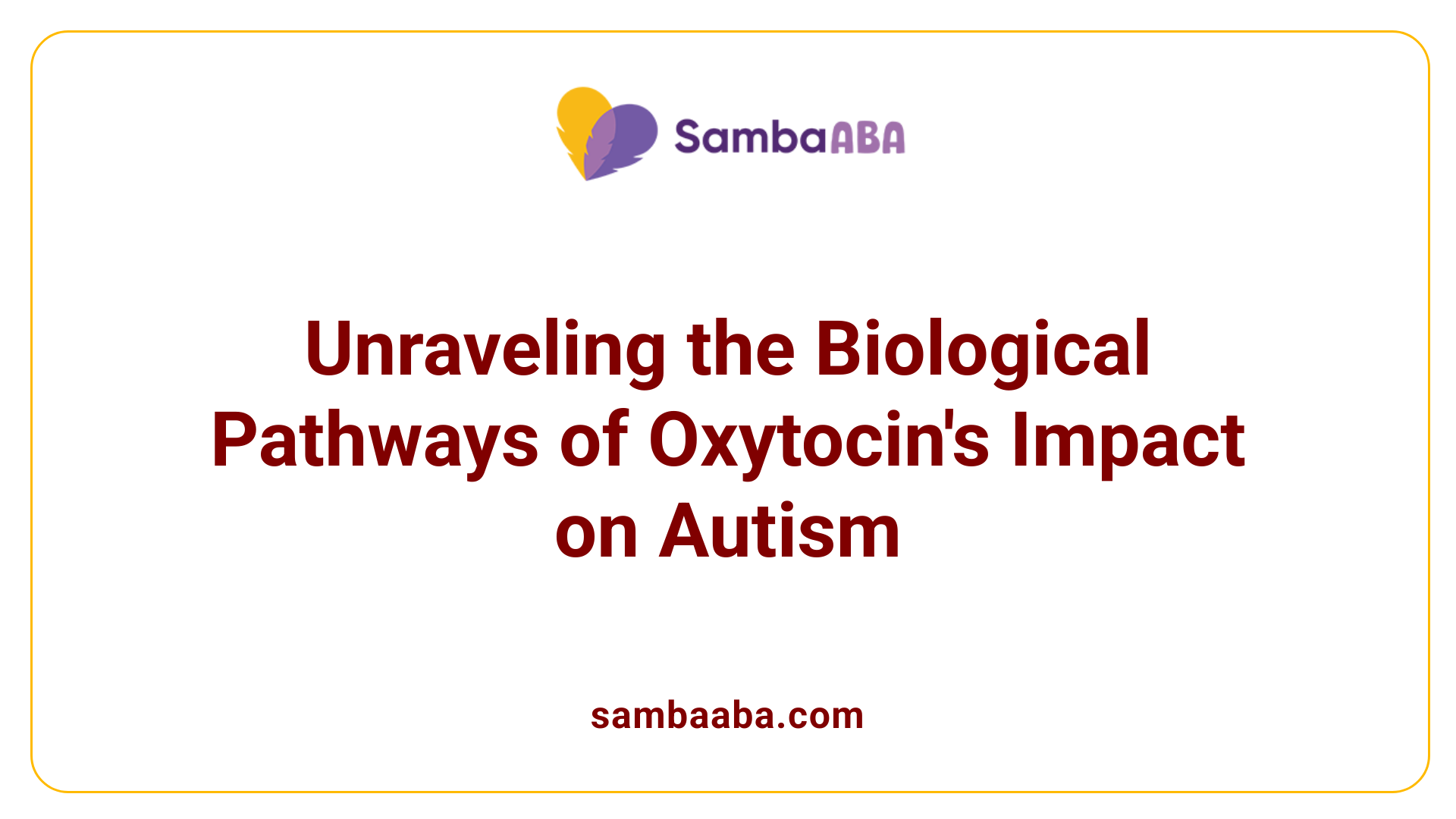
What are the biological mechanisms through which oxytocin may influence autism symptoms?
Oxytocin, often called the social bonding hormone, plays a crucial role in many social behaviors, and its influence on autism spectrum disorder (ASD) symptoms is of significant interest. This hormone is primarily produced in the hypothalamus, specifically in the paraventricular and supraoptic nuclei, and then projects to various brain regions associated with social cognition, reward, and emotional regulation.
These projections help regulate key neural pathways involved in social recognition, the experience of social reward, and threat responses. For instance, oxytocin modulates activity in the amygdala, a brain area involved in fear and threat processing, often overactive in individuals with ASD. By reducing amygdala reactivity, oxytocin can potentially diminish social anxiety and facilitate approach behaviors.
Another critical pathway involves the nucleus accumbens, a part of the brain’s reward system. Oxytocin influences this region to enhance the intrinsic reward of social interactions, which may be diminished in autism. This modulation can help increase motivation for social engagement and improve social recognition.
Beyond neural circuit modulation, oxytocin also impacts gene regulation at the epigenetic level. Studies indicate that increased oxytocin levels are associated with decreased DNA methylation at specific sites on the oxytocin receptor gene (OXTR). Less methylation generally correlates with higher gene expression, leading to increased receptor availability. This suggests that boosting oxytocin receptor expression could improve the brain's sensitivity to endogenous oxytocin, thereby enhancing social functionalities.
Furthermore, oxytocin affects the neural excitatory-inhibitory balance, a fundamental aspect of healthy neural network function. Dysregulation in this balance, with excessive excitation or insufficient inhibition, has been linked to ASD symptoms. Oxytocin can promote inhibitory neurotransmission, such as enhancing GABAergic activity, thus restoring some of the neural homeostasis necessary for social cognition.
In summary, oxytocin’s influence on autism involves complex interactions within brain circuits related to social recognition and reward, epigenetic modifications that augment receptor expression, and regulation of neural excitatory and inhibitory signals. These mechanisms underpin the potential of oxytocin as a biological agent that could modify core social deficits in autism, particularly when the system’s natural levels or receptor functions are compromised.
Current Research and Clinical Trials Exploring Oxytocin Treatments in Autism
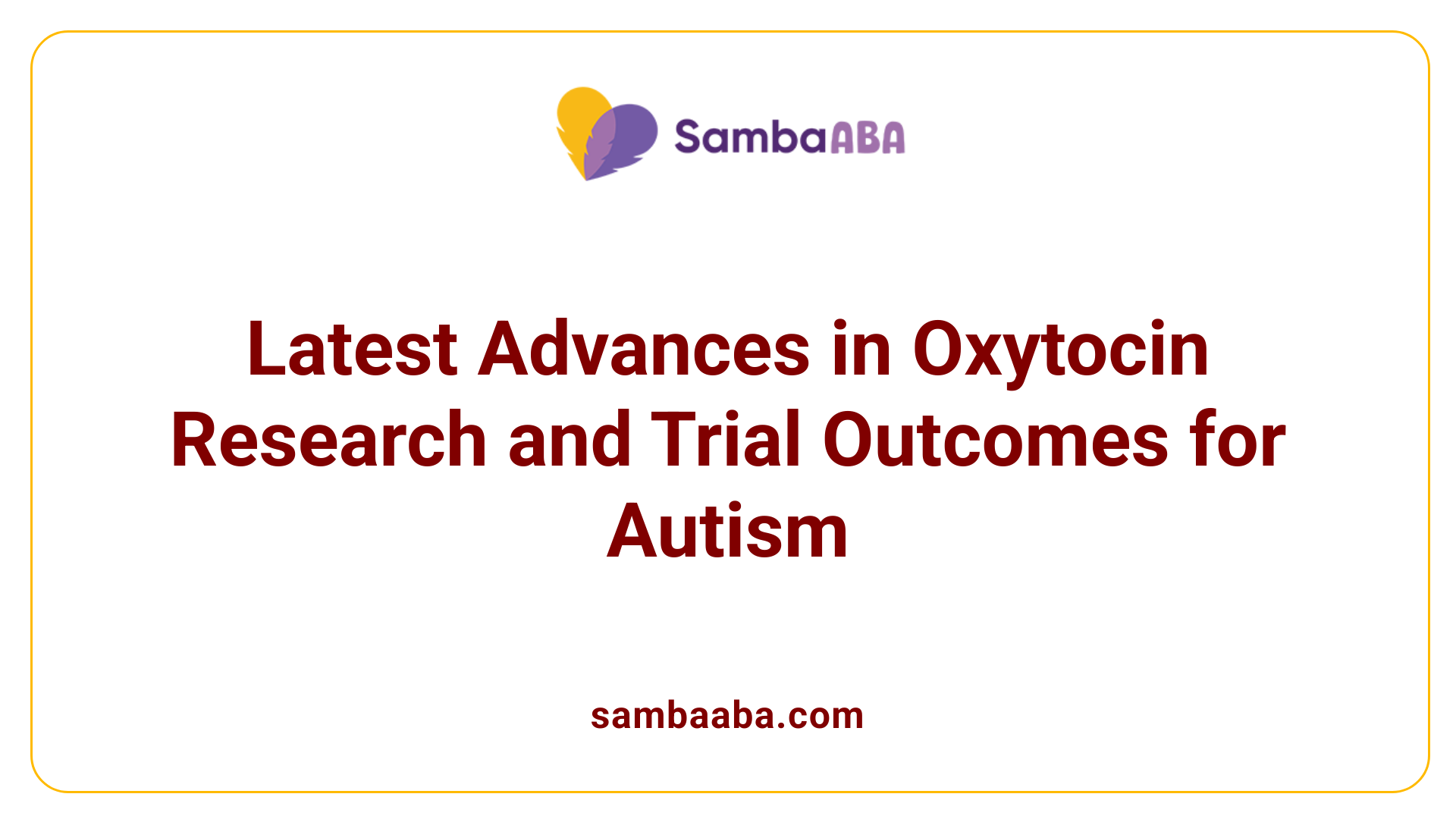
What recent research and clinical trials have explored the effects of oxytocin on autism symptoms?
In recent years, numerous studies and clinical trials have investigated the potential of oxytocin as a treatment for the social difficulties characteristic of autism spectrum disorder (ASD). The research indicates a nuanced picture, with some studies showing promising results while others highlight the complexity of oxytocin's effects.
A significant early trial by Stanford University found that intranasal oxytocin improved social behaviors in children with autism, particularly among those with low levels of baseline oxytocin. This study involved 32 children who received oxytocin or a placebo twice daily for four weeks. Children starting with lower oxytocin levels experienced greater improvements in social interaction, eye contact, and emotional recognition. These findings suggest that baseline oxytocin levels could predict how well a child responds to treatment.
Another noteworthy trial, a large-scale Phase II study sponsored by Duke University (NCT01944046), involved 290 children and adolescents with autism. This placebo-controlled, double-blind trial assessed the safety, tolerability, and efficacy of intranasal oxytocin over a 24-week period. Results published in the New England Journal of Medicine in 2021 reported modest but significant reductions in core autism symptoms, particularly in social withdrawal and social responsiveness. This trial set a new benchmark, demonstrating that oxytocin could have a measurable impact in a large population.
Some studies have extended their focus beyond behavioral outcomes to examine biological effects. Researchers observed that chronic oxytocin administration increases salivary oxytocin levels temporarily and causes epigenetic modifications, such as decreased DNA methylation at the oxytocin receptor gene (OXTR). These changes are associated with improved social attachment and decreased social anxiety, providing insight into possible mechanisms of action.
Large-scale placebo-controlled trials and their outcomes
While early trials showed promising behavioral improvements, larger studies have produced mixed results. A comprehensive meta-analysis of 31 studies revealed a small but statistically significant positive effect of oxytocin on social outcomes, with an effect size (d) of approximately 0.22. However, this effect size diminishes when adjusting for publication bias, reducing the likelihood that the benefits are as strong as initially reported.
The largest trial to date, involving nearly 300 participants, failed to demonstrate a broad, consistent benefit across all measures of social behavior. Although some individuals showed notable improvements, others did not respond, underscoring the heterogeneity of autism and response variability.
Ongoing research aims to refine dosage, treatment duration, and delivery methods to maximize benefits, suggesting that future trials could yield more definitive answers.
Biological effects such as changes in salivary oxytocin and receptor gene methylation
Several studies have focused on the biological impact of oxytocin administration. Chronic intranasal delivery increased salivary oxytocin levels 24 hours after the last dose but returned to baseline after four weeks, implying temporary hormonal elevation.
Importantly, epigenetic studies found that oxytocin treatment decreased DNA methylation at certain CpG sites in the OXTR gene. This change indicates increased receptor expression potential, which may enhance social cognition and attachment behaviors.
Furthermore, post-treatment assessments show that higher salivary oxytocin levels are associated with improved feelings of secure attachment and social engagement among children with autism.
Individual variability in treatment response and baseline levels
One consistent theme in recent research is the variability in response among individuals. Children with lower baseline oxytocin tend to benefit more from treatment, suggesting that personal biological profiles influence outcomes.
Additionally, some children exhibit greater biological changes, such as receptor gene methylation reductions, correlating with behavioral improvements. Conversely, children with normal or higher baseline oxytocin levels often show minimal benefits, underscoring the importance of personalized approaches.
This variability emphasizes the need for biomarkers, such as baseline oxytocin levels or genetic markers, to tailor treatments more effectively.
Potential for personalized treatment approaches based on biomarkers
The emerging evidence indicates that oxytocin could be most beneficial when used as part of a personalized therapy strategy. Measuring baseline blood or salivary oxytocin levels and OXTR methylation status may help identify children who are more likely to respond positively.
Furthermore, ongoing research is exploring combinations of oxytocin with behavioral interventions like joint attention and social motivation training. Such combined approaches might amplify the benefits, especially in individuals with biological markers indicating oxytocin deficits.
Ultimately, these advancements could lead to more targeted, effective interventions for children with ASD, moving toward a precision medicine model.
| Study/Trial | Population | Main Focus | Key Findings | Additional Notes |
|---|---|---|---|---|
| Stanford Study | 32 children with autism | Behavioral effects | Improved social behavior linked to low baseline levels | 4-week intranasal treatment |
| Duke Phase II | 290 children/adolescents | Symptom reduction over 24 weeks | Reduced social withdrawal and increased social responsiveness | Largest trial to date |
| Meta-Analysis | 31 studies | Effect size of oxytocin on social behavior | Small positive effect, diminishes after bias correction | Focus on heterogeneity |
| Biological Studies | Various | Hormone and gene effects | Increased salivary oxytocin; decreased OXTR methylation | Links biological changes with behavioral improvements |
Overall, current research underscores oxytocin's potential in improving social functioning in autism, especially when tailored to individual biological profiles. Nonetheless, larger and more detailed trials are essential to confirm these benefits and optimize treatment protocols.
Potential Implications for Diagnostics and Therapeutics
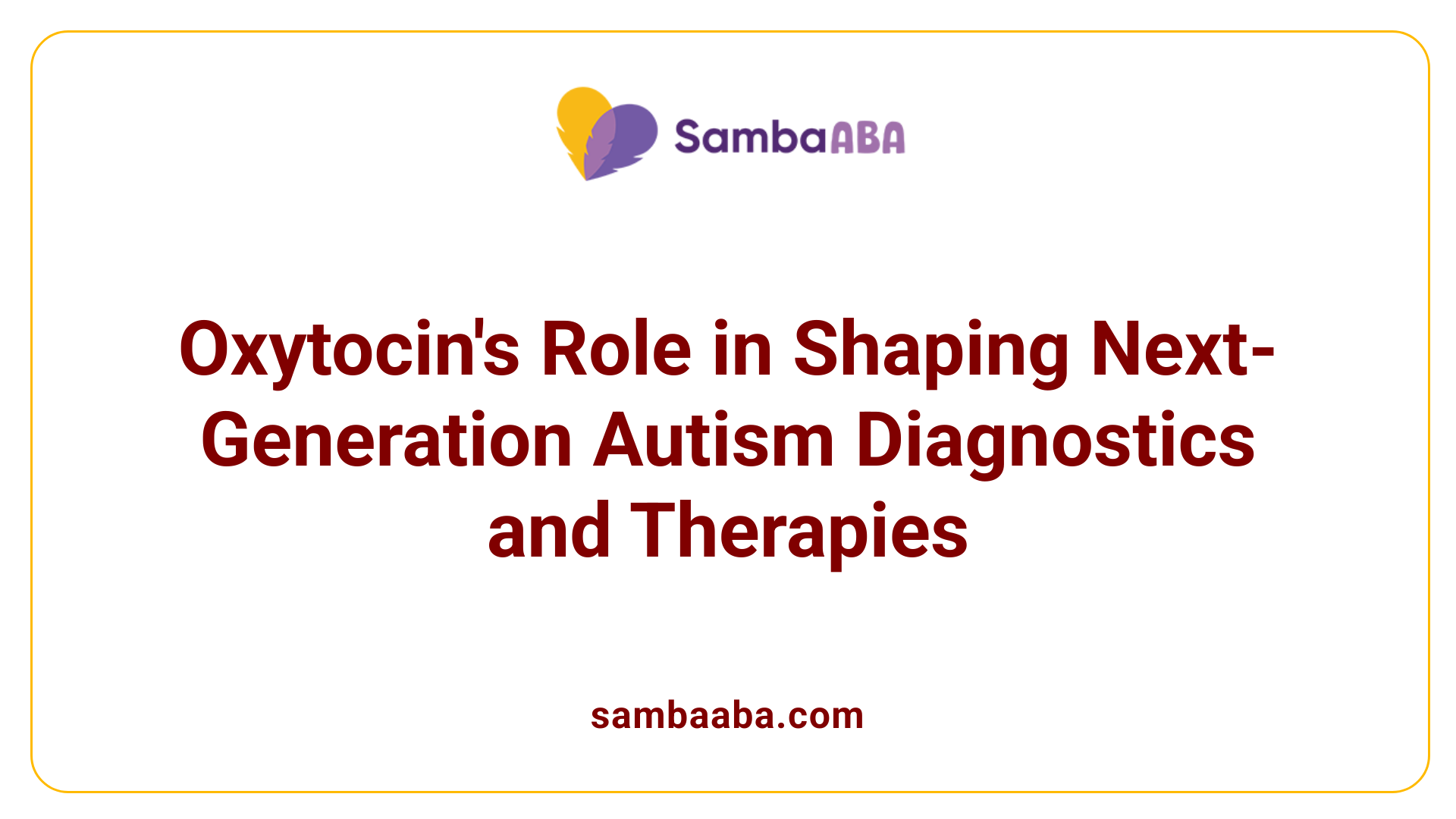
How might oxytocin research impact the diagnosis or treatment of autism spectrum disorder?
Research into oxytocin’s role in autism has uncovered important insights into biological and behavioral aspects of the condition. Several studies have shown that children with autism tend to have lower blood oxytocin levels compared to neurotypical children, especially during the morning. These lower levels are linked with greater social impairments, suggesting that oxytocin could be an influential factor in social behavior and attachment.
Experimental evidence indicates that increasing oxytocin levels—whether through intranasal administration or influencing receptor expression—may enhance social responsiveness. For instance, a notable 2017 Stanford study demonstrated that some children with autism experienced improvements in social behaviors following oxytocin treatment, particularly those with initially low baseline levels. This suggests that measuring oxytocin in blood could serve as a biological marker, helping to identify subgroups within the autism spectrum who might benefit most from targeted treatments.
This potential for baseline oxytocin levels to predict treatment response is significant, offering a pathway toward more personalized or "precision" approaches to autism care. By tailoring interventions based on biological markers, clinicians could improve the likelihood of positive outcomes and reduce unnecessary treatments.
While promising, such applications are still in early stages. The small sample sizes of initial studies mean larger, more comprehensive trials are needed to validate the use of oxytocin as a biomarker. Still, this line of research could revolutionize how autism is diagnosed and treated, shifting from a purely behavioral approach to one that incorporates biological insights.
The prospect of personalized or precision medicine approaches in autism care
The variability in oxytocin levels and the heterogeneous nature of autism suggest that a one-size-fits-all treatment is unlikely to be effective for everyone. The concept of precision medicine—customizing treatment based on individual biological profiles—emerges as a promising strategy.
In this context, oxytocin levels could help classify individuals according to their likelihood of responding to oxytocin-based therapies. For example, children with low baseline oxytocin or certain receptor gene polymorphisms might be prioritized for specific interventions. Moreover, the extent to which oxytocin receptor expression can be modulated, as indicated by DNA methylation studies, could offer additional targets for personalized treatment plans.
The goal is to develop diagnostic tools that assess oxytocin-related biomarkers, informing clinicians about the best course of action for each patient. These tools could include blood tests for oxytocin concentration, genetic analyses of receptor variants, or neuroimaging techniques to observe brain activity patterns related to social processing.
Such approaches would mark a significant advance in autism care, moving away from generic treatments to strategies tailored to individual neurobiology.
Oxytocin-based therapies and their integration into behavioral interventions
While initial clinical trials with intranasal oxytocin have yielded mixed results—some showing improvements in social behaviors and others showing no significant benefit—the integration of pharmacological and behavioral therapies remains a promising avenue.
Oxytocin may enhance social motivation and recognition early in treatment, making behavioral interventions, such as social skills training or joint attention therapy, more effective. Combining oxytocin administration with structured behavioral programs could foster greater engagement and facilitate long-term improvements.
Moreover, ongoing research suggests that oxytocin's effects may be more pronounced in individuals with specific deficits in the oxytocin system. Personalized approaches that combine biological markers with tailored behavioral strategies hold the greatest potential.
The development of protocols that optimize timing, dosage, and delivery routes of oxytocin is crucial for maximizing effectiveness. Currently, methods such as nasal spray are most common, but refining these protocols based on individual response is an active area of investigation.
Challenges in optimizing treatment parameters
Despite encouraging findings, several challenges hinder the widespread adoption of oxytocin therapies. Determining the ideal dosage, duration, and timing remains complex, as responses vary widely among individuals.
The effects of chronic administration, including receptor gene methylation changes and alterations in hormone levels, require further understanding. Additionally, the moderate and sometimes inconsistent results in clinical trials highlight the necessity for rigorous, controlled studies to identify which subgroups benefit most.
Assessing long-term safety and potential side effects is vital before oxytocin can become a standard treatment. Researchers are also exploring the neurobiological mechanisms underlying oxytocin’s effects to refine therapeutic strategies.
Need for reliable tools to assess symptom changes
Accurate measures are essential to evaluate the efficacy of oxytocin-based treatments. Current assessments include behavioral ratings, neuroimaging, and biochemical markers, but each has limitations.
Developing standardized, sensitive tools that can reliably track changes over time will be critical. These tools should incorporate multiple modalities—behavioral, biological, and neural—to provide a comprehensive picture of treatment effects.
Advances in neuroimaging and molecular biology hold promise for creating objective markers that can guide treatment adjustments and predict long-term outcomes.
| Aspect | Current Status | Future Directions | Additional Notes |
|---|---|---|---|
| Baseline oxytocin as biomarker | Promising but needing validation | Larger population studies | Could inform personalized treatment plans |
| Treatment efficacy | Mixed results across studies | Standardized protocols | Focus on specificity and individual response |
| Integration with behavioral therapy | Experimental but promising | Combined approach development | Aims to enhance long-term social functioning |
| Treatment optimization | Challenging due to variability | Dose-response studies | Essential for safe, effective use |
| Symptom assessment tools | In development | Multimodal assessments | To accurately measure benefits |
Research on oxytocin’s role in autism is evolving rapidly. While initial findings are promising, it is clear that translating these insights into clinical practice requires further investigation. Successful integration of biological markers with personalized treatments could eventually transform autism diagnostics and intervention strategies, making care more precise, effective, and tailored to individual needs.
Oxytocin's Effect on Brain Regions Associated with Autism
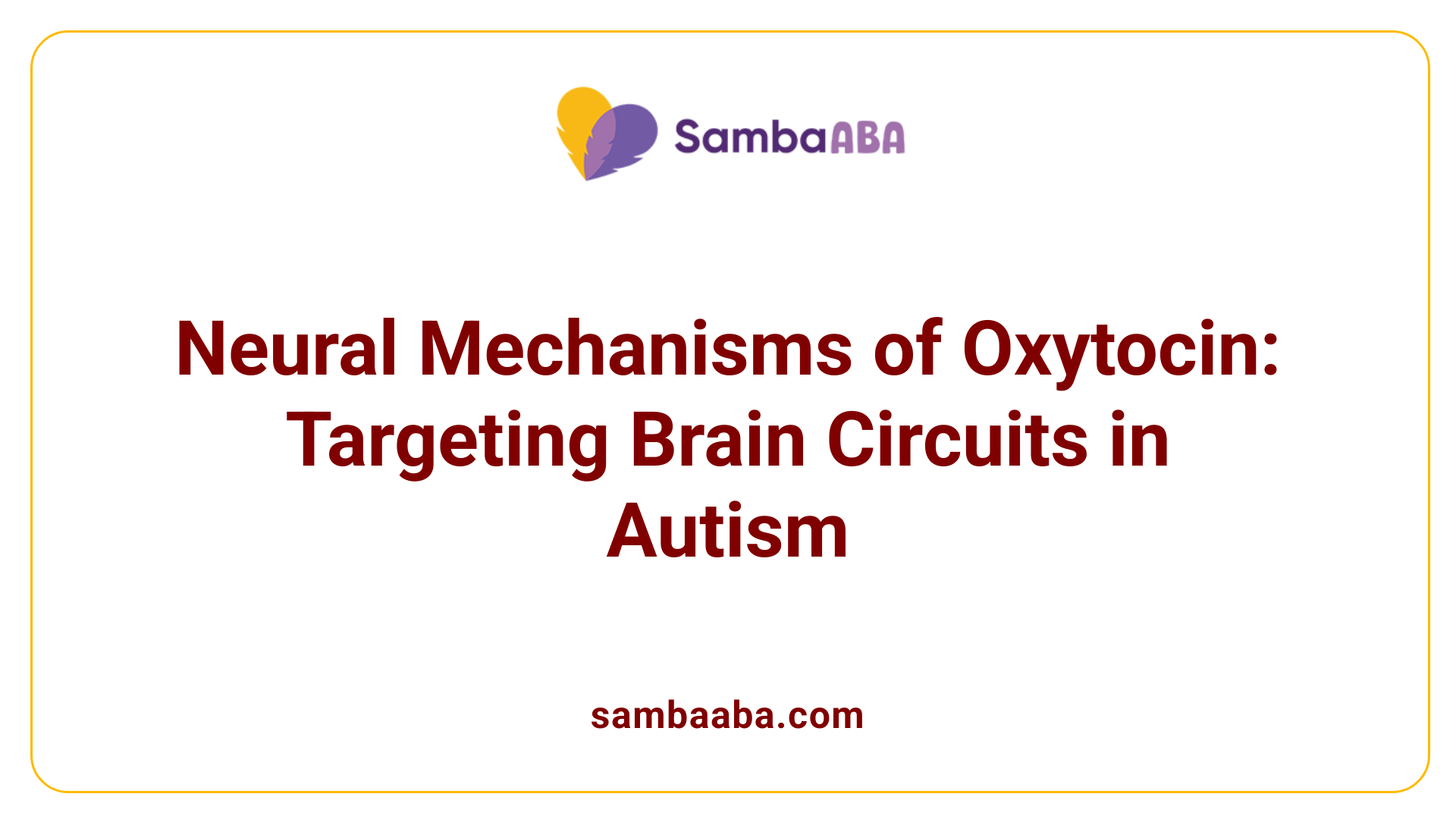
How does oxytocin influence brain mechanisms associated with autism?
Research indicates that oxytocin can significantly impact brain regions involved in social cognition, which are often affected in autism spectrum disorder (ASD). Notably, it modulates activity in areas such as the amygdala, prefrontal cortex, superior temporal sulcus, and striatum.
The amygdala, a key player in processing fear and social signals, shows decreased activation after oxytocin administration, potentially reducing social anxiety and fear responses. This modulation supports a more open and engaging response to social stimuli.
In the prefrontal cortex, especially areas related to social decision-making and cognitive control, oxytocin enhances activity, which can improve social judgment and emotional regulation.
The superior temporal sulcus, involved in gaze processing and interpreting biological motion, responds more robustly to social cues under the influence of oxytocin. This increase in responsiveness helps individuals with ASD to better recognize and attend to social signals.
The striatum, central to reward processing, also shows increased activity following oxytocin treatment. This boosts the salience of social stimuli, making social interactions feel more rewarding and motivating.
Neuroimaging studies employing functional MRI have demonstrated that oxytocin elevates neural responses to social stimuli. For instance, increased activity in the nucleus accumbens and medial prefrontal cortex correlates with enhanced social motivation and attention.
Enhancement of neural responses to social cues by oxytocin contributes to normalized brain responses, where social stimuli are more effectively processed, improving understanding and engagement.
Some studies highlight that oxytocin not only boosts activity but may also help recalibrate category selectivity within social brain networks. This means a clearer distinction between social and nonsocial stimuli, which is often blurred in individuals with autism.
Overall, these neural effects support the idea that oxytocin can improve social perception and behavior by targeting core brain circuits of social cognition.
Many neuroimaging experiments reveal that oxytocin’s impact is task-dependent, actively enhancing brain activity during social judgments, especially in regions governing social recognition, emotional processing, and reward.
Though promising, the variability in individual responses and differences in administration protocols suggest that more research is needed to optimize oxytocin therapies and fully understand its neural effects.
In sum, oxytocin influences autism-related brain mechanisms by increasing activity in social cognition and reward areas, promoting social motivation and processing capabilities, and potentially helping to normalize atypical brain responses to social cues.
Summary and Future Directions in Oxytocin and Autism Research
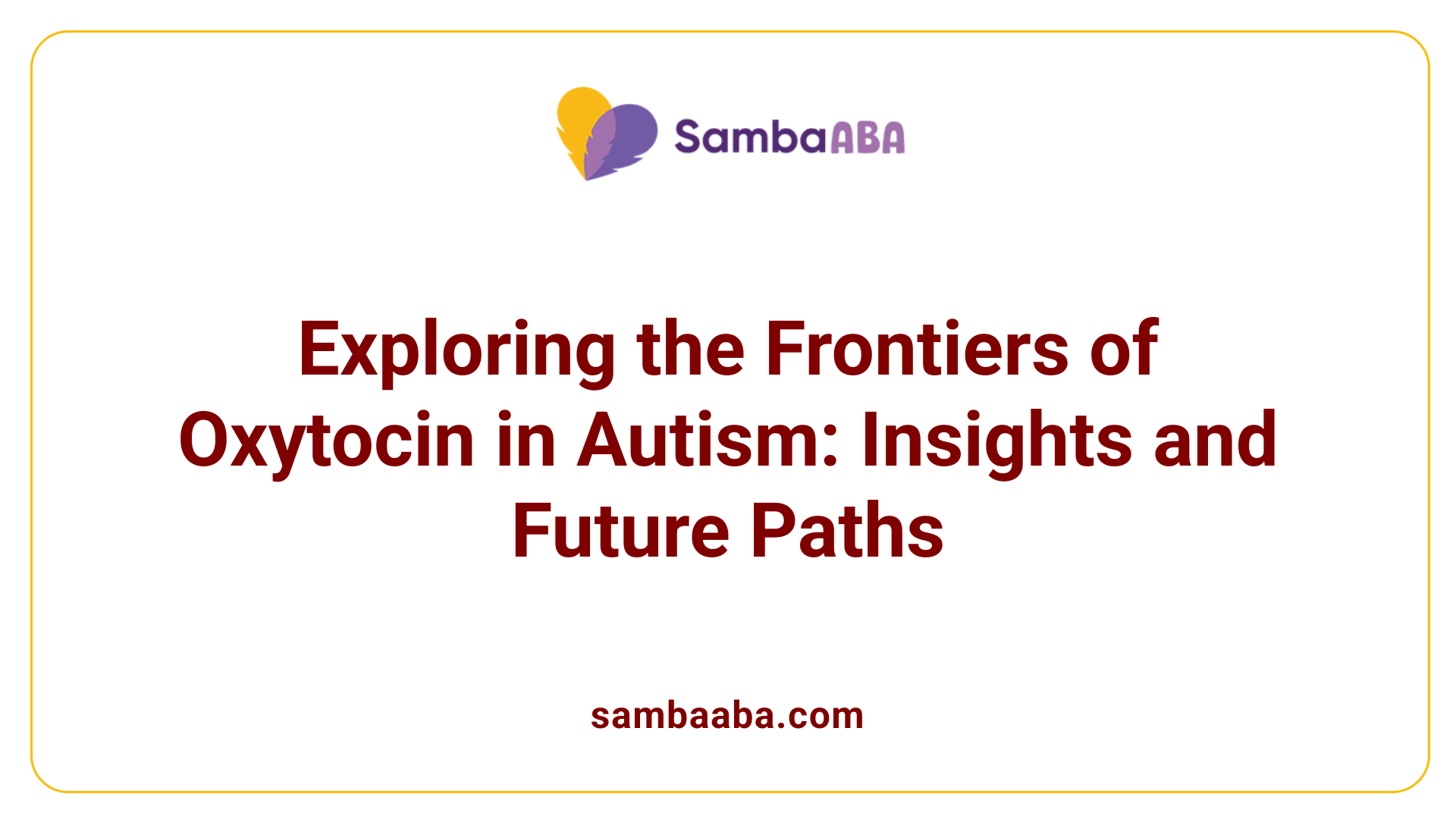
What is the current scientific understanding of the relationship between oxytocin and autism spectrum disorder?
Research into the connection between oxytocin and autism has produced nuanced insights, but no definitive conclusions. Many studies report that children with autism tend to have lower circulating blood oxytocin levels compared to neurotypical children. This has led to the hypothesis that oxytocin deficits might contribute to the social difficulties characteristic of ASD.
However, recent large-scale investigations challenge this idea. For instance, a significant study involving nearly 200 children, including those with autism, found no substantial difference in baseline oxytocin levels between autistic and non-autistic groups. These findings suggest that low oxytocin levels are not universally characteristic of individuals with ASD, but may vary depending on individual and developmental factors.
The relationship between oxytocin and social behaviors in ASD is complex. Experimental administration of intranasal oxytocin has been shown to improve certain social responses, such as gaze on faces, emotion recognition, and trust, especially in individuals with lower baseline oxytocin levels. Neuroimaging studies further support a modulatory role of oxytocin by enhancing activity in brain regions crucial for social cognition, including the amygdala, prefrontal cortex, and temporal regions.
Despite these promising biochemical and neuroimaging results, the clinical efficacy of oxytocin as a treatment remains controversial. Meta-analyses reveal small effect sizes and highlight the heterogeneity of study methods, doses, and populations. Some trials show transient improvements, but large, placebo-controlled phase III trials generally report limited or no significant benefits in core ASD symptoms.
This inconsistency underscores the complexity of translating biological effects into meaningful behavioral improvements. Both the diversity in study designs and the variability in individual responses complicate interpretation. Consequently, the current consensus emphasizes that while oxytocin influences social neural circuits, its role as an effective therapy for ASD is not yet established.
Gaps in understanding and ongoing debates
Several major gaps hinder progress. The neurobiological pathways through which oxytocin might improve social functioning are not fully elucidated. For example, the degree to which peripheral oxytocin levels reflect central nervous system activity remains uncertain. Moreover, optimal dosing strategies, frequency, and duration of treatment are not standardized, leading to variable outcomes.
Ongoing debates focus on whether oxytocin's effects are primarily neurochemical, behavioral, or a combination of both. Some researchers argue that oxytocin might be more effective in specific subgroups, such as those with documented oxytocin deficiencies or certain genetic profiles, rather than universally across ASD populations.
Another controversy involves the sustainability of treatment effects. While some studies observe short-term improvements, the long-term impact of chronic oxytocin administration is largely unknown. Potential side effects and receptor desensitization further complicate the clinical outlook.
Importance of large, well-controlled trials and standardized protocols
To resolve these issues, robust research methodologies are paramount. Larger randomized, placebo-controlled trials with standardized protocols for dosing, administration routes, and outcome measures are necessary. These trials should include biomarker assessments, like blood oxytocin levels and receptor gene methylation, to identify potential responders.
The use of uniform outcome measures across studies would facilitate meta-analyses and allow clearer assessment of efficacy. Incorporating neuroimaging and genetic analyses could also shed light on mechanisms and help stratify individuals most likely to benefit.
Potential for personalized medicine and biomarker development
Emerging evidence suggests that personalized approaches based on biological markers could enhance treatment outcomes. For example, children with low baseline oxytocin or specific OXTR gene polymorphisms may be more responsive to treatment.
Monitoring oxytocin levels and receptor methylation status could serve as predictors of response, individualizing therapeutic strategies. This precision medicine approach aligns with broader trends in neuropsychiatric treatments—moving away from one-size-fits-all therapies towards tailored interventions.
Emerging neurobiological and genetic investigations
Finally, advancements in neurobiology and genetics are shedding light on the underlying mechanisms. Studies indicate alterations in oxytocin receptor expression and epigenetic modifications, such as DNA methylation, in individuals with ASD. These findings could guide the development of targeted therapies.
Additionally, animal models continue to provide insights, demonstrating that genetic mutations affecting the oxytocin system impair social recognition, which can be mitigated by oxytocin administration.
In summary, while oxytocin remains a promising candidate influencing social cognition in autism, current evidence underscores the need for further high-quality research. Future studies should focus on biological markers, gene-environment interactions, and personalized approaches to refine and optimize potential therapeutic pathways.
Moving Forward in Oxytocin and Autism Research
While the research into oxytocin's role in autism has produced promising insights into the biological and neural underpinnings of social behavior deficits, definitive evidence for its therapeutic use remains elusive. The variability in clinical outcomes underscores the complexity of autism and the need for personalized approaches that consider individual biological markers. Future studies focused on standardizing treatment protocols, understanding long-term effects, and identifying biomarkers will be essential. Despite current limitations, ongoing research continues to illuminate how modulation of the oxytocin system could eventually lead to more targeted and effective interventions, offering hope for improving social functioning and quality of life for individuals with ASD.
References
- Researchers report new findings about oxytocin and ASD
- Study shows which children with autism respond best to oxytocin ...
- Chronic oxytocin administration stimulates the oxytocinergic system ...
- Oxytocin and Autism Spectrum Disorders - PubMed
- Oxytocin and autism: Insights from clinical trials and animal models
- Can oxytocin help improve social skills in kids with autism? It's ...
- Research Review: Social motivation and oxytocin in autism
- Association of Epidural Analgesia, Oxytocin, and Risk of Autism ...
- Oxytocin therapy and autism | Raising Children Network
- Associations with cortisol levels and oxytocin receptor gene ... - Nature
